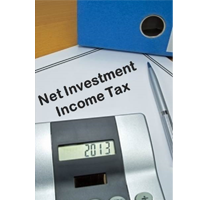
Investor Education | How to cope with net investment income tax
The 3.8% surtax on “net investment income,” often called the NII tax, has been around since 2013, but investors are still trying to figure out all its ins and outs. By taking a close look at the beginning of the new year, you can assess the likelihood of owing the NII tax in 2016 and devise ways to avoid or minimize it.
Background: The 3.8% tax applies to the lesser of NII or the amount by which modified adjusted gross income (MAGI) exceeds $200,000 for single filers and $250,000 for joint filers. For this purpose, NII includes interest, dividends, capital gains, rents, royalties, nonqualified annuities, income from the trading of financial instruments or commodities. Yet certain other items— such as wages, self-employment income, Social Security benefits, tax-exempt interest, operating income from a non-passive business, and distributions from qualified retirement plans and IRAs—are excluded. Depending on your situation, you may be able to counteract the NII tax. Here are several ideas.
- Invest in municipal bonds. The income from tax-exempt municipal bonds (“munis”) doesn’t count toward either NII or MAGI, so you might add munis to your portfolio or expand your investment. Of course, you should ensure that this meets your portfolio goals and tolerance for risk. Become more involved in passive activities. If you are an investor in a business that you do not operate, the income you realize from the business will generally be included as NII. However, if you “materially participate” in the business, the income does not count in the NII calculation. Generally, you can qualify by spending more than 500 hours a year on the activity. Note: Special rules apply to rental real estate.
- Set up a charitable remainder trust (CRT). With a CRT, you can generally claim a current tax deduction for the gift of the remainder interest while receiving income for a period of years or your lifetime. The CRT can help avoid the surtax on highly appreciated capital gains.
- Use a leapfrog annuity. By investing in a tax-deferred annuity, you can receive payments in retirement, while “leapfrogging” the high-income years when you might be liable for the 3.8% surtax. This strategy may be especially advantageous if you expect to be in a lower tax bracket in retirement than you are now.
This is a brief overview of just a few potential strategies to address the NII tax. Develop an overall investment plan that suits your personal needs.
This newsletter/advertisement is produced for our clients, friends and associates through an arrangement with WPI Communications, Inc. for the representatives’ use. Although the editorial content is professionally researched, written and edited, neither our firm nor any of its agents, representatives or associates make any representations regarding the accuracy of the content or its applicability to your situation. The information in this communication is not intended as tax or legal advice. In accordance with IRS Circular 230, the information provided herein may not be relied on for purposes of avoiding any federal tax penalties. Any tax advice contained in the body of this material was not intended or written to be used, and cannot be used, by the recipient for the purpose of 1) avoiding penalties that may be imposed under the Internal Revenue Code or applicable state or local tax law provisions, or 2) promoting, marketing or recommending to another party any transaction or matter addressed herein. You are encouraged to seek tax or legal advice from an independent advisor.
Learn More | Contact Our Investment Specialists
Investment Consultant
Tam Hubert, CFP®, CFA
Investment Assistant
Kristi Remus

